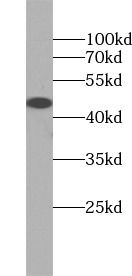Products
MEK1/2 antibody
Category:
Research Area:
| Synonyms: | ERK activator kinase 2 antibody, FLJ26075 antibody, MAP kinase kinase 2 antibody, MAP2K2 antibody, MAPK/ERK kinase 2 antibody, MAPKK 2 antibody, MAPKK2 antibody, MEK 2 antibody, MEK2 antibody, MKK2 antibody, PRKMK2 antibody | ||
| Catalogue No.: | FNab05113 | Reactivity: | Human, Mouse, Rat |
| Host: | Rabbit | Tested Application: | ELISA, IHC, WB |
| Clonality: | polyclonal | Isotype: | IgG |
- SPECIFICATIONS
- Product Name
- MEK1/2 antibody
- Catalogue No.
- FNab05113
- Size
- 100μg
- Form
- liquid
- Purification
- Immunogen affinity purified
- Purity
- ≥95% as determined by SDS-PAGE
- Clonality
- polyclonal
- Isotype
- IgG
- Storage
- PBS with 0.02% sodium azide and 50% glycerol pH 7.3, -20℃ for 12 months (Avoid repeated freeze / thaw cycles.)
Immunogen
- Immunogen
- mitogen-activated protein kinase kinase 2
- Alternative Names
- ERK activator kinase 2 antibody, FLJ26075 antibody, MAP kinase kinase 2 antibody, MAP2K2 antibody, MAPK/ERK kinase 2 antibody, MAPKK 2 antibody, MAPKK2 antibody, MEK 2 antibody, MEK2 antibody, MKK2 antibody, PRKMK2 antibody
- UniProt ID
- P36507
- Observed MW
- 53 kDa
Application
- Tested Applications
- ELISA, IHC, WB
- Recommended dilution
- WB: 1:500 - 1:2000; IHC: 1:50 - 1:200
Validated Images
 HL-60 cells were subjected to SDS PAGE followed by western blot with FNab05113(MAP2K2 antibody) at dilution of 1:1000
HL-60 cells were subjected to SDS PAGE followed by western blot with FNab05113(MAP2K2 antibody) at dilution of 1:1000
 Immunohistochemistry of paraffin-embedded human kidney using FNab05113(MAP2K2 antibody) at dilution of 1:100
Immunohistochemistry of paraffin-embedded human kidney using FNab05113(MAP2K2 antibody) at dilution of 1:100
- Background
- The protein encoded by this gene is a dual specificity protein kinase that belongs to the MAP kinase kinase family. This kinase is known to play a critical role in mitogen growth factor signal transduction. It phosphorylates and thus activates MAPK1/ERK2 and MAPK2/ERK3. The activation of this kinase itself is dependent on the Ser/Thr phosphorylation by MAP kinase kinase kinases. Mutations in this gene cause cardiofaciocutaneous syndrome (CFC syndrome), a disease characterized by heart defects, mental retardation, and distinctive facial features similar to those found in Noonan syndrome. The inhibition or degradation of this kinase is also found to be involved in the pathogenesis of Yersinia and anthrax. A pseudogene, which is located on chromosome 7, has been identified for this gene.



